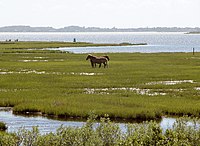
Back الحصان الوحشي Arabic Cavall feral Catalan Vildhest Danish Wildpferd German Sovaĝiĝinta ĉevalo Esperanto Caballo cimarrón Spanish Basazaldi Basque Cheval sauvage French Cavallo inselvatichito Italian ಕಾಡು ಕುದುರೆ(ಕುದುರೆ) Kannada
This article needs additional citations for verification. (May 2015) |



A feral horse is a free-roaming horse of domesticated stock. As such, a feral horse is not a wild animal in the sense of an animal without domesticated ancestors. However, some populations of feral horses are managed as wildlife, and these horses often are popularly called "wild" horses. Feral horses are descended from domestic horses that strayed, escaped, or were deliberately released into the wild and remained to survive and reproduce there. Away from humans, over time, these animals' patterns of behavior revert to behavior more closely resembling that of wild horses. Some horses that live in a feral state but may be occasionally handled or managed by humans, particularly if privately owned, are referred to as "semi-feral".
Feral horses live in groups called a herd, band, harem, or mob. Feral horse herds, like those of wild horses, are usually made up of small harems led by a dominant mare, containing additional mares, their foals, and immature horses of both sexes. There is usually one herd stallion, though occasionally a few less-dominant males may remain with the group. Horse "herds" in the wild are best described as groups of several small bands who share the same territory. Bands are normally on the small side, as few as three to five animals, but sometimes over a dozen. The makeup of bands shift over time as young animals are driven out of the band they were born into and join other bands, or as young stallions challenge older males for dominance. However, in a closed ecosystem (such as the isolated refuges in which most feral horses live today), to maintain genetic diversity, the minimum size for a sustainable free-roaming horse or burro population is 150–200 animals.[1]
- ^ "American Wild Horse Preservation Campaign". wildhorsepreservation.com. Archived from the original on 21 November 2011. Retrieved 21 May 2015.